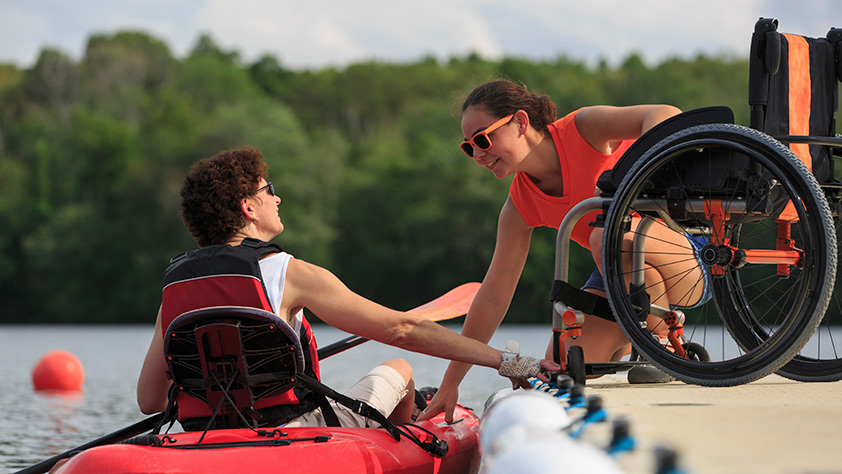Health challenges and mobility issues don’t mean you have to stay home. In fact, the opposite is true—“travel enriches our lives in ways that nothing else can,” assures Adam Lloyd, editor of disability travel website GimpontheGo.com.
Candy B. Harrington, editor of EmergingHorizons.com and author of accessible travel books, including “Barrier-Free Travels; A Nuts and Bolts Guide for Wheelers and Slow Walkers,” agrees: “Travel increases your independence and gives you a real feeling of accomplishment, which you can carry back into your daily life.”
It’s true: Travel is very empowering, and today it’s easier than ever to plan an accessible vacation, thanks to increased regulations, the internet and new construction built with accessibility in mind. Likewise, tourism employees are far more familiar and experienced with interacting with passengers who have special physical requirements today, adds Lloyd. The key is planning. Take a look:
Accessible destinations
While mobility challenged travelers may have an easier time in popular tourist destinations that are more familiar with accessibility issues (think Disney, Vegas and cruises), the sky is truly the limit when it comes to what you can do, encourages Lloyd, a quadriplegic, paralyzed from the neck down, who has taken his wheelchair into a Costa Rican rainforest, in a gondola to the top of the German Alps and out to the middle of Stonehenge.
It’s all a matter of knowing your limits and adjusting your expectations. “I’m often willing to forgo ease and comfort [for the] experience,” says Lloyd, who admits he has to accept that there are certain things he’s just not able to see or do. Likewise, “many types of adventure travel require physical assistance (like being lifted and carried), so if you’re not comfortable with that, these aren’t a good choice for you,” says Harrington, adding that most third-world countries lack a truly accessible infrastructure.
“There are lots of travel options, tour agencies and adapted activities all around the world, but finding them is the most challenging part, which is why I started my site,” adds Ashley Lyn Olson, founder and editor of wheelchairtraveling.com. Olson has found some of the most accessible cities in the world to be in western North America, like Vancouver, Maui, Portland, San Francisco, San Diego and Denver, and abroad in countries like Spain, Australia and Japan.
“These places aren’t always 100 percent accessible, but they are 100 percent possible,” says Olson. “Whether it’s scuba diving in Egypt, a Safari tour in Africa, zip-lining in Ecuador or taking a hot air balloon ride in California, there are accessible options for all.”
No matter where you go, a good attitude is tantamount. “One of the best gifts of accessible travel is that you have to challenge yourself to find new ways to do things, which often results in seeing things you wouldn’t see as a regular tourist,” says Olson. “Embrace it and let people help you—they’ll come out of nowhere to interact, to pay for your meal, to help.”
Air travel
Air travel accessibility has improved drastically over the years and thanks to standardized procedures and laws, it’s easier than ever to know what to expect. Here are 5 tips to keep in mind:
1. Notify the airline ahead of time what kind of help you will require at each step along the way, from ticketing to check-in to boarding, says Olson. “The clearer the airline's employees are about the exact assistance you need them to provide, the better job they will do at providing it,” adds Lloyd.
2. If you have any issues walking long distances, request an airport wheelchair, advises Harrington. “Some airports are huge, and you don’t want to be so tired after your flight that you can’t enjoy your vacation.”
3. Passengers with mobility challenges are pre-boarded to give them ample time to get settled. However, they’re also the last to leave the plane. Fortunately, this means you won’t ever become “a spectacle for other passengers to watch as you are assisted on and off the plane,” assures Lloyd.
4. Learn the laws, suggests Harrington, who recommends reviewing The Air Carrier Access Act. “It’s written in a very approachable question-and-answer format, so you’ll know what to expect, and when something isn’t going according to the book, and you can speak up.” If a problem does arise, you have to file complaints with both the chief CRO and the DOT, cautions Olson.
5. Wheel chairs are sometimes treated as luggage and without care, warns Olson. Here are her tips for traveling with one:
- Get a gate check ticket attached to your wheelchair, so it won’t be sent to baggage claim when you land.
- Take off any loose parts or anything that could possibly fall of the wheelchair and store it on the plane to ensure it doesn’t get lost or damaged.
- If you have power chair, bubble wrap the joystick, and bring a backup manual wheelchair to be safe. Fortunately, medical equipment can be checked for free, so you’ll even have some extra space to pack other items with your backup chair.
- Attach laminated disassembly directions in multiple languages to the wheelchair.
- Get travel insurance.
Hotels and lodging
Likewise, the more information you exchange with a hotel about your requirements, the more likely it is that your accommodations will meet your physical needs, says Lloyd. Be specific—not all accessible rooms are created equal, so let the hotel know if you have difficulty getting into beds of a certain height, or easy access to elevators, wide doorways or bathrooms with hand-held showers, roll-in showers or shower benches. If you’re not sure what you need, don’t hesitate to ask questions. And remember, accessibility extends beyond the room, so be sure to inquire about pools, restaurants and other common areas, advises Lloyd.
Cruises
“Cruises are a wonderful way for people with mobility challenges to visit multiple destinations while remaining in the same, mobility-friendly floating hotel,” says Lloyd, noting that nearly all cruise lines in the U.S. offer terrific accessibility on their ships. Adds Harrington: Cruises are providing this access voluntarily—there are no regulations that specify what type of access features ships must have, so ask questions and specify your needs upfront.
While the ships themselves are often accessible, the ports of call do not always adhere to the accessibility standards you’re used to in America, especially in Caribbean and remote or underdeveloped destinations. So it’s important to learn about port accessibility and the type of excursions offered before you book a cruise. Lloyd recommends Hawaiian or Alaskan cruises, where the ports of call are within America and accessible excursion options are more prolific. Read through Cruise Critic for detailed trip reports and forums for disabled cruising.
Rental cars and scooters
When it comes to rental cars, most major agencies (Hertz, Alamo, Enterprise) offer vehicles with adaptive driving devices, like hand controls, left foot accelerators, spinner knobs and pedal extenders, at no extra charge. It’s recommended you request them in advance, ideally when you book your reservation to ensure ample time for the company to equip your vehicle.
If you need wheelchair-accessible vans, check out Wheelchair Getaways, Wheelers Van Rentals and Accessible Vans of America. Similarly, scooter rentals are available through companies like Scootaround, though Harrington says you can save money by renting from a medical supply place in your hometown.












